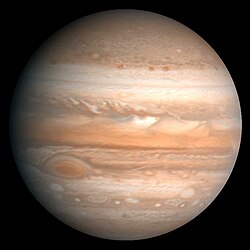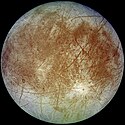Galileiska månar
| Den här artikeln behöver fler eller bättre källhänvisningar för att kunna verifieras. (2019-06) Åtgärda genom att lägga till pålitliga källor (gärna som fotnoter). Uppgifter utan källhänvisning kan ifrågasättas och tas bort utan att det behöver diskuteras på diskussionssidan. |
De galileiska månarna är ett samlingsnamn för Jupiters fyra stora månar Callisto, Ganymedes, Europa och Io, vilka beskrevs av Galileo Galilei i början av 1600-talet under namnet de "Mediceiska stjärnorna". Upptäckten anses betydelsefull för astronomin, då det var det första ovedersägliga beviset på himlakroppar som gick i omloppsbana runt en annan himlakropp än jorden.
Galilei gjorde den första observationen 7 januari 1610. Till en början kallade Galilei sin upptäckt Cosmica Sidera för att hedra sin beskyddare storhertigen Cosimo II de' Medici (1590–1621). På storhertigens förslag ändrade Galilei namnet till Medicea Sidera (de "mediceiska stjärnorna"), efter de fyra bröderna Medici: Cosimo, Francesco, Carlo och Lorenzo.
I mars 1610, mindre än två månader efter den första observationen, publicerade Galilei upptäckten i sin skrift Sidereus Nuncius. Skriften beskrev också hans tre första upptäckter med teleskopet: att månens yta inte är slät, att det finns många fler stjärnor än som kan ses med blotta ögat och att planeterna inte är lysande punkter som stjärnorna utan små lysande skivor.[1]

| Namn | Bild | Diameter (km) | Massa (kg) | Densitet (g/cm³) | Halv storaxel (km)[2] | Siderisk omloppstid(d) [3] (relativ) | Inklination (°) | Excentricitet |
|---|---|---|---|---|---|---|---|---|
| Io Jupiter I | 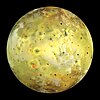 | 3660 × 3637 × 3631 | 893×1022 | 3,528 | 421800 | 1,769 (1) | 0,050 | 0,0041 |
| Europa Jupiter II | 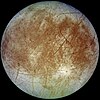 | 3122 | 48×1022 | 3,014 | 671100 | 3,551 (2) | 0,471 | 0,0094 |
| Ganymedes Jupiter III |  | 5268 | 148×1023 | 1,942 | 1070400 | 7,155 (4) | 0,204 | 0,0011 |
| Callisto Jupiter IV | 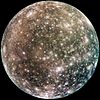 | 4821 | 108×1023 | 1,834 | 1882700 | 16,69 (9,4) | 0,205 | 0,0074 |
Referenser
- ^ Weinberg, Steven (2016) [2015]. To Explain the World – The Discovery of Modern Science. Penguin Books. sid. 175–178. ISBN 978-0-141-98087-4
- ^ ”NaturalSatellites” (på engelska). IAU Minor Planet Center. Arkiverad från originalet den 20 maj 2011. https://archive.is/20110520031937/http://www.minorplanetcenter.org/iau/NatSats/NaturalSatellites.html. Läst 2 januari 2018.
- ^ ”Moons of Jupiter” (på engelska). NASA. https://www.nasa.gov/sites/default/files/files/Moons_of_Jupiter_Lithograph.pdf. Läst 2 januari 2018.
Se även
| |||||||||||||||||||||||||||||||||||||||||||||||||
Media som används på denna webbplats
Författare/Upphovsman: Tkgd2007, Licens: CC BY-SA 3.0
A new incarnation of Image:Question_book-3.svg, which was uploaded by user AzaToth. This file is available on the English version of Wikipedia under the filename en:Image:Question book-new.svg
Original Caption Released with Image:
NASA's Galileo spacecraft acquired its highest resolution images of Jupiter's moon Io on 3 July 1999 during its closest pass to Io since orbit insertion in late 1995. This color mosaic uses the near-infrared, green and violet filters (slightly more than the visible range) of the spacecraft's camera and approximates what the human eye would see. Most of Io's surface has pastel colors, punctuated by black, brown, green, orange, and red units near the active volcanic centers. A false color version of the mosaic has been created to enhance the contrast of the color variations.
The improved resolution reveals small-scale color units which had not been recognized previously and which suggest that the lavas and sulfurous deposits are composed of complex mixtures (Cutout A of false color image). Some of the bright (whitish), high-latitude (near the top and bottom) deposits have an ethereal quality like a transparent covering of frost (Cutout B of false color image). Bright red areas were seen previously only as diffuse deposits. However, they are now seen to exist as both diffuse deposits and sharp linear features like fissures (Cutout C of false color image). Some volcanic centers have bright and colorful flows, perhaps due to flows of sulfur rather than silicate lava (Cutout D of false color image). In this region bright, white material can also be seen to emanate from linear rifts and cliffs.
Comparison of this image to previous Galileo images reveals many changes due to the ongoing volcanic activity.
Galileo will make two close passes of Io beginning in October of this year. Most of the high-resolution targets for these flybys are seen on the hemisphere shown here.
North is to the top of the picture and the sun illuminates the surface from almost directly behind the spacecraft. This illumination geometry is good for imaging color variations, but poor for imaging topographic shading. However, some topographic shading can be seen here due to the combination of relatively high resolution (1.3 kilometers or 0.8 miles per picture element) and the rugged topography over parts of Io. The image is centered at 0.3 degrees north latitude and 137.5 degrees west longitude. The resolution is 1.3 kilometers (0.8 miles) per picture element. The images were taken on 3 July 1999 at a range of about 130,000 kilometers (81,000 miles) by the Solid State Imaging (SSI) system on NASA's Galileo spacecraft during its twenty-first orbit.
The Jet Propulsion Laboratory, Pasadena, CA manages the Galileo mission for NASA's Office of Space Science, Washington, DC.
This image and other images and data received from Galileo are posted on the World Wide Web, on the Galileo mission home page at URL http://galileo.jpl.nasa.gov. Background information and educational context for the images can be found at URL http://www.jpl.nasa.gov/galileo/sepo.Jupiter's moon Ganymede.
Bright scars on a darker surface testify to a long history of impacts on Jupiter's moon Callisto in this image of Callisto from NASA's Galileo spacecraft. The picture, taken in May 2001, is the only complete global color image of Callisto obtained by Galileo, which has been orbiting Jupiter since December 1995. Of Jupiter's four largest moons, Callisto orbits farthest from the giant planet. Callisto's surface is uniformly cratered but is not uniform in color or brightness. Scientists believe the brighter areas are mainly ice and the darker areas are highly eroded, ice-poor material.
Animation of the 1:2:4 Laplace resonance between Io, Europa, and Ganymede. The labels indicate the ratios of orbital periods: Europa's is twice Io's, and Ganymede's is four times Io's.
Warning: do not downsize the image below its original size of 365 × 245 when used in a Wikipedia article, as the animation won't move then (at least not for all users).
Original Caption Released with Image: This processed color image of Jupiter was produced in 1990 by the U.S. Geological Survey from a Voyager 2 image captured in 1979. The colors have been enhanced to bring out detail. Zones of light-colored, ascending clouds alternate with bands of dark, descending clouds. The clouds travel around the planet in alternating eastward and westward belts at speeds of up to 540 kilometers per hour. Tremendous storms as big as Earthly continents surge around the planet. The Great Red Spot (oval shape toward the lower-left) is an enormous anticyclonic storm that drifts along its belt, eventually circling the entire planet.
This "family portrait," a composite of the Jovian system, includes the edge of Jupiter with its Great Red Spot, and Jupiter's four largest moons, known as the Galilean satellites. From top to bottom, the moons shown are Io, Europa, Ganymede and Callisto. The Great Red Spot, a storm in Jupiter's atmosphere, is at least 300 years old. Winds blow counterclockwise around the Great Red Spot at about 400 kilometers per hour (250 miles per hour). The storm is larger than one Earth diameter from north to south, and more than two Earth diameters from east to west. In this oblique view, the Great Red Spot appears longer in the north-south direction. Europa, the smallest of the four moons, is about the size of Earth's moon, while Ganymede is the largest moon in the solar system. North is at the top of this composite picture in which the massive planet and its largest satellites have all been scaled to a common factor of 15 kilometers (9 miles) per picture element. The Solid State Imaging (CCD) system aboard NASA's Galileo spacecraft obtained the Jupiter, Io and Ganymede images in June 1996, while the Europa images were obtained in September 1996. Because Galileo focuses on high resolution imaging of regional areas on Callisto rather than global coverage, the portrait of Callisto is from the 1979 flyby of NASA's Voyager spacecraft.
This image shows a view of the trailing hemisphere of Jupiter's ice-covered satellite, Europa, in approximate natural color. Long, dark lines are fractures in the crust, some of which are more than 3,000 kilometers (1,850 miles) long. The bright feature containing a central dark spot in the lower third of the image is a young impact crater some 50 kilometers (31 miles) in diameter. This crater has been provisionally named "Pwyll" for the Celtic god of the underworld. Europa is about 3,160 kilometers (1,950 miles) in diameter, or about the size of Earth's moon. This image was taken on September 7, 1996, at a range of 677,000 kilometers (417,900 miles) by the solid state imaging television camera onboard the Galileo spacecraft during its second orbit around Jupiter. The image was processed by Deutsche Forschungsanstalt fuer Luftund Raumfahrt e.V., Berlin, Germany.







